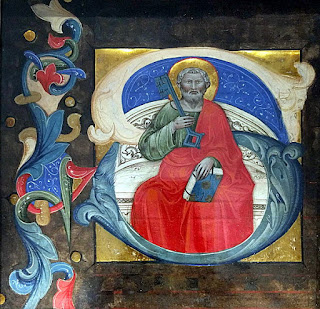Regular readers will know how often the backs of leaves and cuttings provide vital information. There may be a significant attribution (e.g. "From the Cathedral at Como"); a direct indication of a former owner (e.g. notes initialled "TMW" by Thomas Miller Whitehead); an auction lot number that allows it to be identified in a sale catalogue; text and/or music that allows the ambiguous subject-matter of an initial to be identified; or traces of a characteristic type of adhesive mounting-tape, that reveals it to have been sold by Otto Ege.
This week, I started to write a note about some interesting ideas presented by Christopher de Hamel in the Introduction to the recently published catalogue of the Burke Collection [1], but I quickly became side-tracked by his discussion of a cutting from Santa Maria degli Angeli, shown above.
de Hamel reports that the back of the frame is inscribed "stolen by the French in the revolution" and "brought to England by W. Y. Ottley, Esq.". From these quotations, which are presumably excerpts, it is clear neither if they come from a single inscription or from more than one, nor what they say in full. This is completely understandable in the context of the Introduction, but the inscription(s) are not reported in the catalogue entry itelf, and no photo of the back of the cutting is provided, either in the hardcopy catalogue, or in the online presentation of the collection.
With a little effort, however, a more detailed account of the inscription can be tracked-down, in a Sotheby's catalogue for 17 June 1997, lot 30, which records:
"... a long note on the back of the frame (now faded but retranscribed [...] in 1907), describing it as 'an illuminated initial letter from the celebrated Missal at Florence stolen by the French in the revolution. Brought to England by W.Y. Ottley, Esq.'"
Such inscriptions can provide crucial provenance evidence. Quite apart from their textual content (even if this is transcribed in full by a cataloguer), their visual appearance may be paramount: they might be recognisably in the handwriting of someone like William Roscoe, who is known to have bought at least one other Santa Maria degli Angeli illumination from Ottley before 1816 (as discussed in this post), or perhaps Thomas Miller Whitehead, mentioned above (and discussed in several posts such as this one). In the present case, all we really know is that the inscription is not by Ottley, as he is referred to in the third person, and is presumably much earlier than 1907.
Images or transcriptions of such inscriptions can also remove provenance ambiguities. For example, there is an apparent contradiction between the 1997 Sotheby's catalogue and the new Burke catalogue, which would doubtless be removed if we knew what the inscription says. Sotheby's 1997 records that the cutting
"was bought by John George Henry Pownall (1792-1880), magistrate, of Spring Grove, Isleworth, and given in 1856 to his son, Frederick Hyde Pownall, who wrote a long note on the back of the frame (now faded but retranscribed by his own son in 1907)"
while the more recent catalogue's provenance includes:
"London, c.1865-1868, John George Henry Pownall (1792-1880); Frederick Hyde Pownall, 1907"
with no explanation of the "c. 1865-1868" date, no mention of the 1856 gift, and no mention of Frederick's son. Wikipedia tells us that Frederick married in 1856 (which doubtless explains why his father gave him the illumination in that year) and died in 1907 (which doubtless explains why the faded inscription was retranscribed by his son in that year). The Sotheby's description also records that "it has passed by direct descent to the present owners", so we need not look for it in sale records between 1907 and 1997.
As is well known, most of the Celotti and Ottley illuminations are trimmed to the outline of the initial to remove all trace of text or music, even when the outline is as complex as these:
Of interest in the present Burke initial, therefore, is the fact that some text and music survive, and the inscription on the back of the frame reportedly (according to the Sotheby's description) records that the illumination was "mounted in a black tissue paper aperture masking the vellum and pasted up to the extreme edge of the illumination".
This surrounding the illumination with black recalls a very specific aesthetic, versions of which can be found among several of the illuminations at the Wallace Collection, including these:
and at least one of the initials of the Murano Gradual:
[Edit, 23 April 2025: Here is another example, now NYC, Morgan Library, MS M.444:]
[1] The Burke Collection of Italian Manuscript Paintings, ed. by Sandra Hindman and Federica Toniolo (London: Ad Ilissvm, 2021).







No comments:
Post a Comment
** PLEASE INCLUDE YOUR NAME IN YOUR COMMENT **
I may ignore and delete anonymous comments